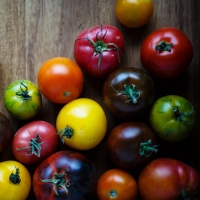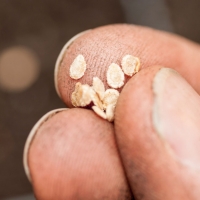Tomatoes
Introduction
Tomatoes are one of the most widely produced and consumed ‘vegetables’ around the world, both for the fresh vegetable market and for the processed food industries. There is a rich biodiversity with many recognisable varieties in varying sizes, shapes and colours.
Classification and taxonomy
The tomato belongs to the family Solanaceae, genus Lycopersicon. The Solanaceae family includes numerous other crops such as chili and bell peppers (Capsicum), potato (Solanum tuberosum), aubergine (Solanum melongena), tobacco (Nicotiana tabacum).
Origin, history and uses
Although all related wild species of tomato could be traced back to the Andean region, mainly Chile, Colombia, Ecuador, Bolivia and Peru, the first extensive domestication seems to have occurred in Mexico. Most probably, the ancestor of tomato is the wild L.esculentum var. Cerasiforme (the ancestor of cherry tomato).
The Spanish colonialists introduced the tomato to Europe at the beginning of the 16th century. Initially, the tomatoes were grown as ornamental plants and their fruits were considered inedible or poisonous. Slowly, throughout the 17th and the 18th century, tomatoes have been introduced in the European cuisine and they started to be cultivated in Southern and North-Western Europe. Around the same period, Europeans brought tomatoes to China, Asia, Japan and, by the 18th century, to the United States.
The word ‘tomato’ comes from the word used by the Aztecs to describe the same species: ‘tomatl’.
Tomatoes can be eaten fresh or in various processed forms, such as: tomato preserves (i.e. tomato paste, tomato juice), dried tomatoes (i.e. tomato powder, dried tomato fruits); tomato-based foods (i.e. ketchup, tomato-based sauces, tomato soups), etc.1
Key facts about tomatoes
Tomatoes are a perennial diploid dicotyledon grown in both open-field systems and greenhouses.
During the last four decades, thanks to knowledge of genetics and farming practices, the production of fresh and processed tomatoes has significantly increased and, by 2016, annual worldwide production reached 130 million tonnes.2
According to FAOSTAT3, the leading global producers are China, the United States, India and Turkey. Within the European Union, Spain and Italy are among the largest tomato producers.
For fresh production, there are various cultivars and varieties which range from small, round-shaped tomatoes to large beefsteak ones, from red ones to yellow and dark-coloured one. According to the British Tomatoes Growers Association4, we can distinguish five major types:
- Classic round tomatoes – the most popular variety, having a round shape and weighting around 70 -100 g.
- Cherry tomatoes – smaller that the classic round tomatoes, weighing around 10 – 20 g.
- Plum tomatoes – they have an oval shape and weight around 50 – 80 g.
- Beefsteak tomatoes – larger than the classic round tomatoes, they contain three up to five locules and weight around 180 – 250 g.
- Vine or truss tomatoes – they can be any of the above-mentioned types and are usually marketed attached to the fruiting stem (since the stems give tomatoes their particular flavour).
More information about tomatoes, their history and major uses, available in Heuvelink, Ep. (eds), Tomatoes, CABI publishing, Cambridge, 2005. ↩
Data regarding the annual worldwide production of tomatoes (as in 2016) available at: https://www.eurofresh-distribution.com/news/around-world-tomatoes, last consulted August 29, 2018. ↩
Food and Agricultural Organisation of the United Nations, Statistics Division : Statistics about the tomato global production are available at http://www.fao.org/faostat/en/#data/QC/visualize, last consulted August 29th, 2018. ↩
British Tomatoes Growers Association provide a list of most common five types of tomatoes, available at http://www.britishtomatoes.co.uk/tomato-facts/tomato-types, last consulted August 29, 2018. ↩
Fun facts

Did you know that…every year the Spanish village of Bunol in Valencia hosts the largest tomato war in the world called ‘La tomatina’?

Did you know that…Lycopersicon, the Latin name of the tomato, means ‘wolf peach’?

Did you know that…tomato seeds have been making trips to the International Space Station for the past 16 years? When compared with their ‘peers’ which remained ‘at home’, no major difference has been found.

Did you know that…back in the 17th – 18th century, French people thought that tomatoes had aphrodisiac properties and called them ‘pommes d’amour’ or ‘love apples’?